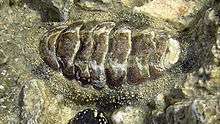Acanthopleura granulata
| Acanthopleura granulata | |
|---|---|
 | |
| Live individual on a rock in Guadeloupe | |
| Scientific classification | |
| Kingdom: | Animalia |
| Phylum: | Mollusca |
| Class: | Polyplacophora |
| Order: | Neoloricata |
| Family: | Chitonidae |
| Genus: | Acanthopleura |
| Species: | A. granulata |
| Binomial name | |
| Acanthopleura granulata (Gmelin, 1791) | |
| Synonyms | |
|
Chiton granulatus Gmelin, 1791, Chiton blauneri Shuttleworth, 1856 | |
Acanthopleura granulata, common name the West Indian fuzzy chiton, is a medium-sized tropical species of chiton.
This species is common within its range in the tropical Western Atlantic, but it is often not noticed, because its color and texture are similar to the rocks on which it lives.
In countries that used to be part of the British West Indies, these and other common intertidal chitons are known as "curb"; the foot of the animal is eaten by people and is also used as bait for fishing.
Description
This species of chiton grows to be about 7 cm (2.8 in) in length.[1] The girdle is densely spiky and usually has a few black bands.
The surface of the valves (or plates) in this species is almost always heavily eroded in adults, but when not eroded, the valve surface is granulated. The valves are thick and heavy.
Distribution
This chiton occurs from southern Florida to Mexico, south to Panama, and in the West Indies.[1][2]
Ecology
This species lives on rocks very high in the intertidal zone.[3] It can tolerate a lot of sun. Feeding is primarily nocturnal. It feeds on several species of algae.[4]
Gallery
 Two valves of A. granulata, an intermediate plate (32 mm) and a tail plate (21 mm)
Two valves of A. granulata, an intermediate plate (32 mm) and a tail plate (21 mm) Two individuals of A. granulata in their natural habitat on a rock in Guadeloupe
Two individuals of A. granulata in their natural habitat on a rock in Guadeloupe_(San_Salvador_Island%2C_Bahamas)_1_(16131898481).jpg)

References
- Gmelin, J.F., (1791). Caroli a Linné, Systema naturae per regna tria naturae. Editio decima tertia. Leipzig, Germany: 1(6) class 6, Vermes: 3021-3910
- Abbott, R Tucker (1954). American Seashells. D. Van Nostrand Company Inc. xiv + 541 p. N.York.
- Warmke, Germaine L. & Abbott, R Tucker. 1961. Caribbean Seashells. Livingston Publishing Company. Narbeth. Pennsylvania.
- Speiser, Daniel I., Douglas J. Eernisse & Sönke Johnsen. 2011. A chiton uses aragonite lenses to form images. Current Biology, 21(8):665-670
- Rodríguez, G. 1959. “The marine communities of Margarita Island, Venezuela”. Bulletin of Marine Science of the Gulf and Caribbean, Coral Gables, FL, 9(3): 237-280
- Daniel I. Speiser, Daniel G. DeMartini & Todd H. Oakleya The shell-eyes of the chiton Acanthopleura granulata (Mollusca, Polyplacophora) use pheomelanin as a screening pigment
External links
| Wikimedia Commons has media related to Acanthopleura granulata. |
| Wikispecies has information related to Acanthopleura granulata |